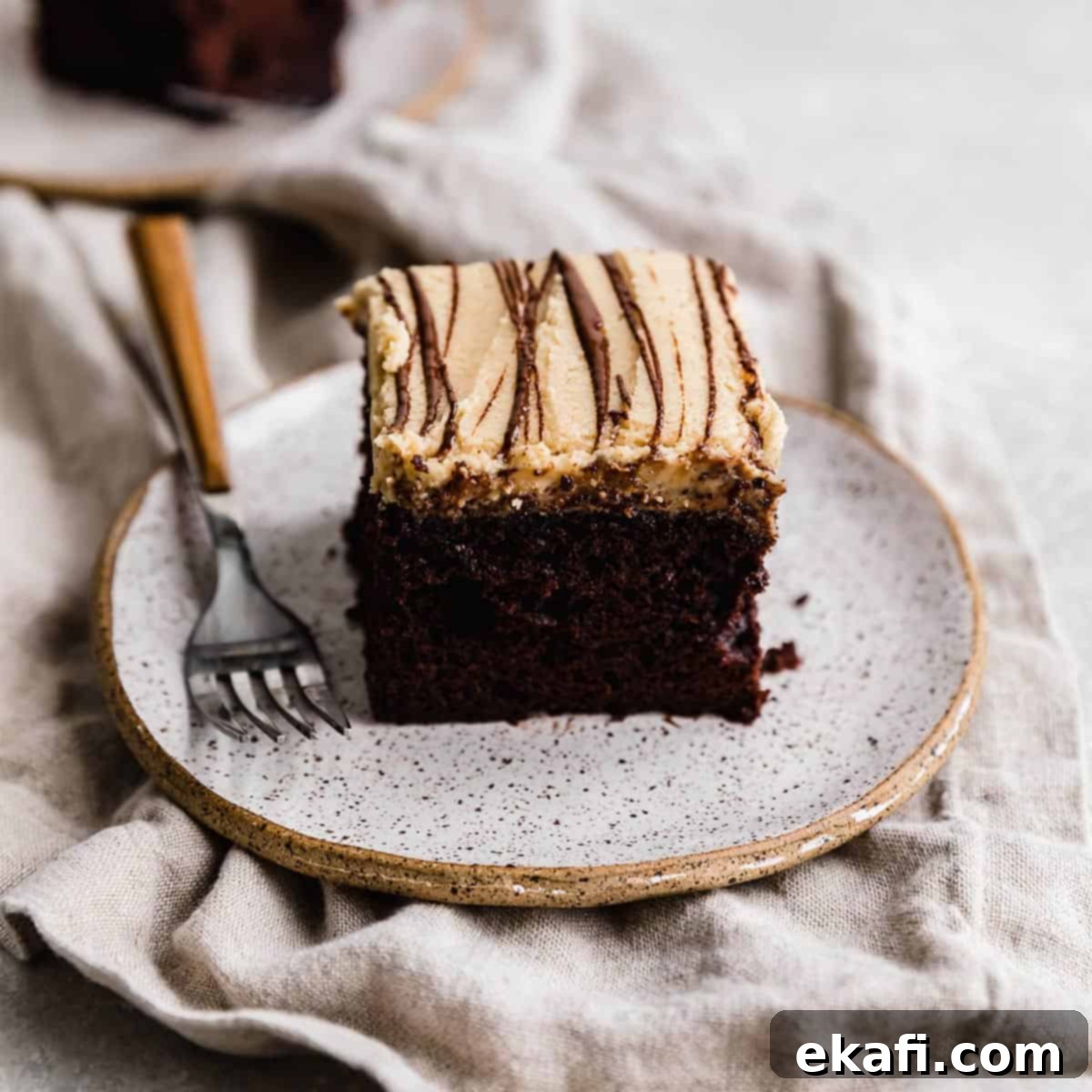Rich & Moist Chocolate Cake with Creamy Peanut Butter Frosting: The Ultimate Indulgence
Prepare to fall in love with the ultimate dessert combination: our Chocolate Cake with Peanut Butter Frosting. This isn’t just any cake; it’s a testament to the magic that happens when a deep, rich, and incredibly moist chocolate cake meets a smooth, light, and irresistibly creamy peanut butter buttercream. Every bite is an experience, a perfect symphony of flavors that will transport you straight to chocolate and peanut butter heaven.
Some culinary pairings are simply destined to be together, and chocolate and peanut butter stand at the pinnacle of this delicious list. As an ardent enthusiast of this classic duo, I can attest to its unparalleled appeal. If you share my passion, you’ll definitely want to explore more of my creations that celebrate this iconic flavor profile. Don’t miss out on my delightful Chocolate Peanut Butter Chip Cookies, the effortlessly easy No-Bake Chocolate Peanut Butter Cookies, the crowd-pleasing Chocolate Peanut Butter Bars, and for a healthier twist, my energizing Chocolate Peanut Butter Protein Balls. Each recipe offers a unique way to enjoy this beloved combination, but for pure indulgence, this cake truly takes the crown.
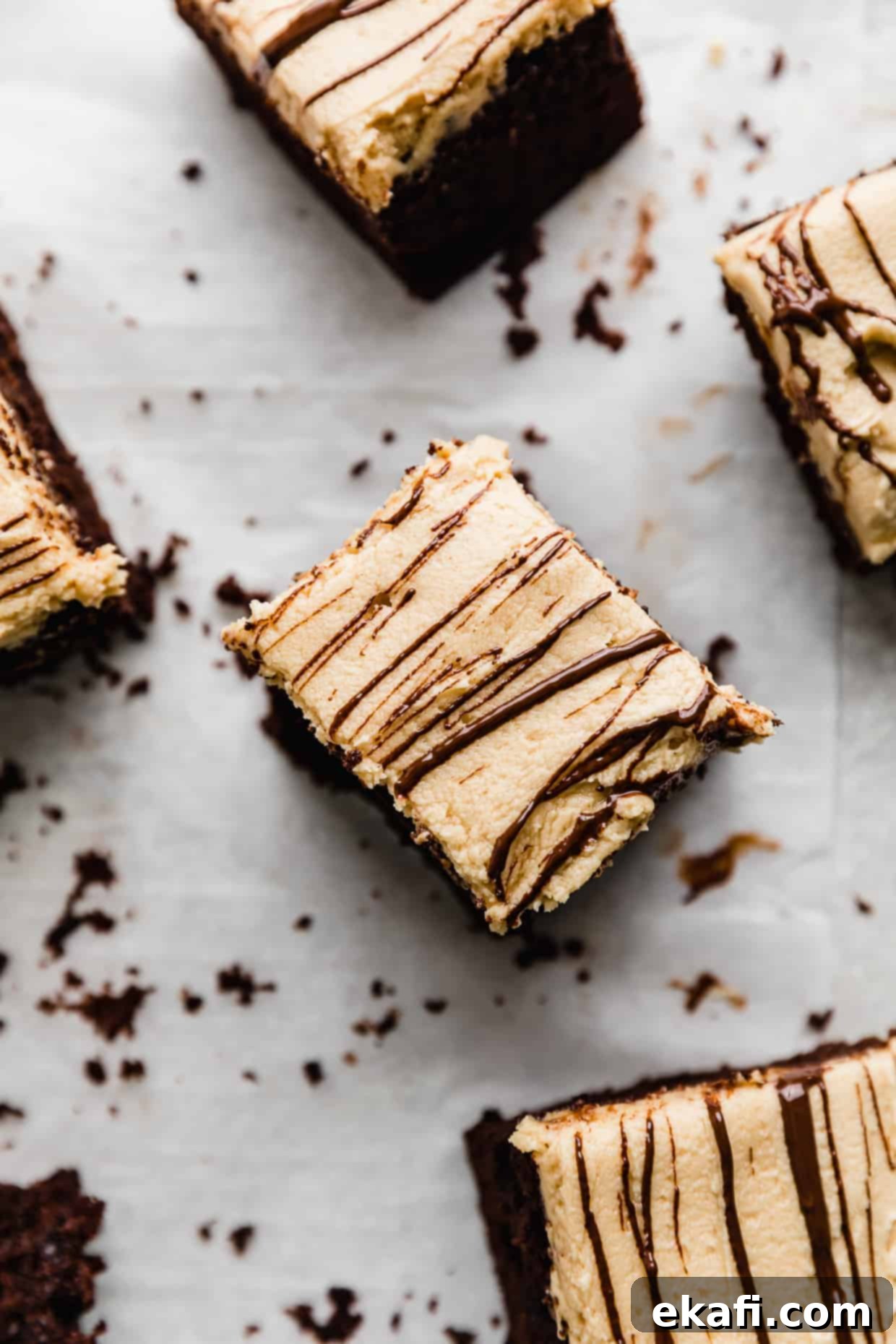
Why This Chocolate Peanut Butter Cake Recipe Works So Well
This recipe isn’t just a collection of ingredients; it’s a carefully crafted method designed to deliver exceptional results every single time. Here’s why this particular chocolate cake with peanut butter frosting will become your new go-to recipe:
- Effortlessly Easy Homemade Chocolate Cake with Peanut Butter Frosting: Forget the often-disappointing and artificial taste of boxed cake mixes. This homemade chocolate cake is incredibly simple to prepare, utilizing common pantry ingredients you likely already have on hand. The steps are straightforward, making it accessible even for novice bakers, yet the results are profoundly superior to anything store-bought. You’ll be amazed at how easily you can create such a show-stopping dessert from scratch!
- Achieving Perfect Cake Texture Every Time: The secret to this cake’s unbelievably moist and tender crumb lies in the thoughtful combination of both oil and butter. Butter contributes rich flavor, but oil, being a liquid at room temperature, excels at keeping cakes consistently moist over time, preventing them from drying out. This dynamic duo ensures a cake that truly melts in your mouth, remaining soft and delicious for days.
- Deep, Rich Chocolate Flavor That Shines Through: We don’t shy away from chocolate here! This recipe calls for a generous 3/4 cup of high-quality cocoa powder, ensuring an intensely chocolatey experience. To further amplify this incredible flavor, we employ a technique known as “blooming” the cocoa powder. By mixing it with hot water, we activate and deepen its chocolate notes, releasing its full aromatic potential and resulting in a cake with a truly profound and satisfying chocolate essence. This simple step makes a world of difference.
- Irresistible Peanut Butter Frosting: The light and airy peanut butter buttercream is the perfect complement to the rich chocolate cake. It’s not overly sweet and has just the right balance of creamy texture and nutty flavor, making it a dream to spread and a delight to eat.
Essential Ingredient Notes for Your Chocolate Peanut Butter Cake
Understanding the role of each ingredient is key to baking success. Here’s a closer look at the components that make this chocolate cake with peanut butter frosting so special:
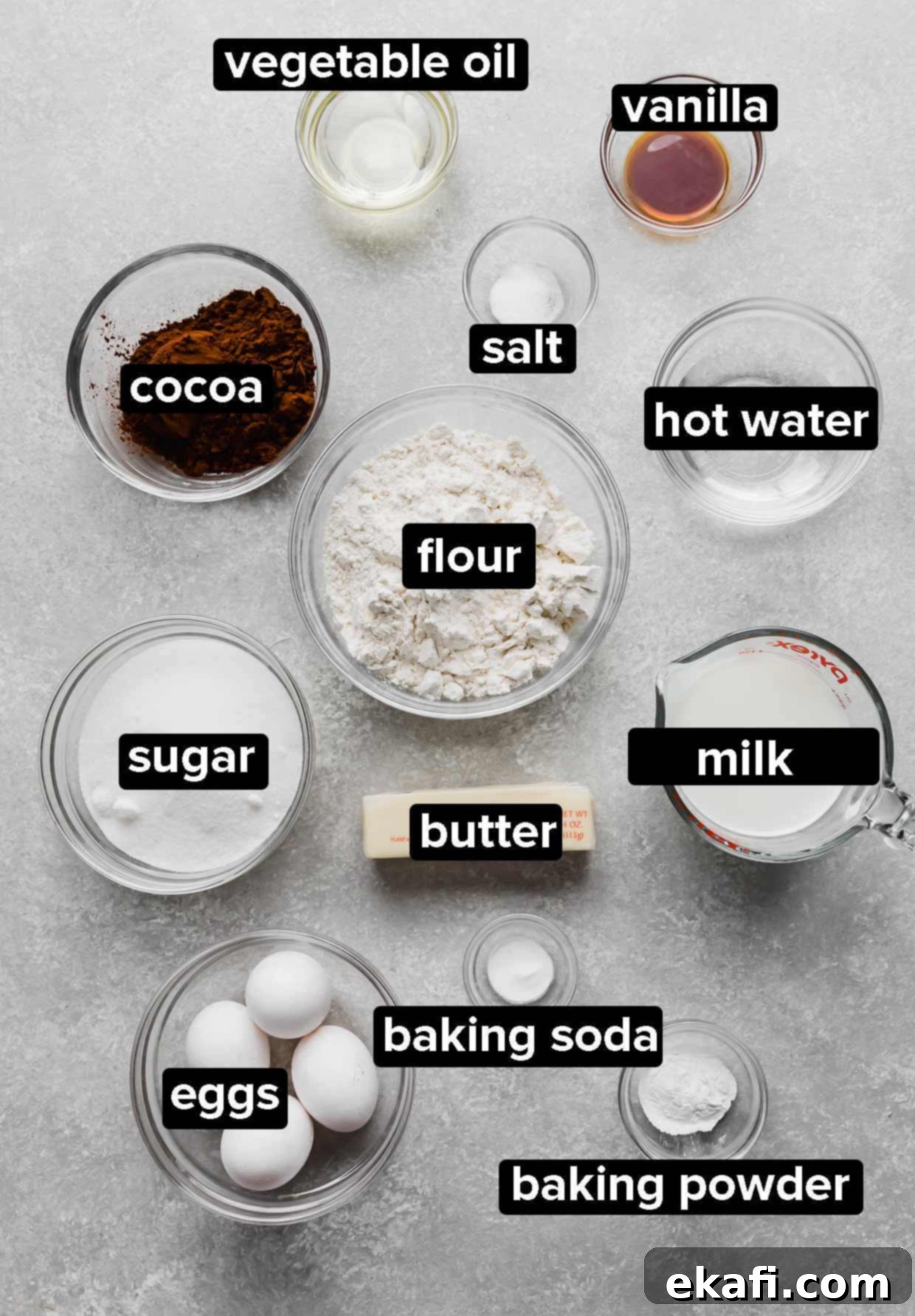
- Cocoa Powder: For this recipe, I highly recommend using Dutch-processed cocoa powder. The key difference between natural and Dutch-processed cocoa powder lies in its acidity. Dutch-processed cocoa has been washed in an alkaline solution, neutralizing its natural acidity. This results in a darker color and a smoother, less bitter, and more mellow chocolate flavor, which pairs beautifully with peanut butter. Natural cocoa powder, on the other hand, is acidic and reacts with baking soda to provide lift; if you use natural cocoa, you might need to adjust the leavening agents. For a deeper dive into the nuances, refer to my comprehensive guide on the Best Cocoa Powder for Baking.
- Eggs: Eggs are foundational in almost all baking, acting as crucial binding agents that hold ingredients together. Beyond structure, they also contribute essential moisture, richness, and serve as a leavening agent, helping the cake rise. For best results, ensure your eggs are at room temperature; this allows them to emulsify more effectively with other ingredients, creating a smoother, more uniform batter.
- Butter: Butter plays a dual role in this chocolate cake. It imbues the cake with a delightful, classic buttery flavor that complements the chocolate and provides a tenderness to the crumb. Like eggs, it’s essential for butter to be softened to room temperature for optimal creaming with sugar, which incorporates air and creates a light texture.
- Vegetable Oil: The addition of vegetable oil is a secret weapon for ensuring an incredibly moist cake. Unlike butter, which is solid at room temperature and can make cakes feel dry as they cool, oil remains liquid, distributing moisture evenly throughout the cake and keeping it tender for longer. Use a neutral-flavored oil like canola, sunflower, or grapeseed oil.
- All-Purpose Flour: This provides the primary structure for the cake. While not specifically mentioned in the original snippet, it’s a crucial ingredient. Sifting your flour can help create a lighter, fluffier cake.
- Granulated Sugar: Beyond sweetness, sugar plays multiple roles: it tenderizes the cake, contributes to browning during baking, and helps retain moisture.
- Baking Powder & Baking Soda: These are chemical leavening agents that work together to give the cake its lift and airy texture. Baking soda typically requires an acid to activate, which is provided by the Dutch-processed cocoa and other ingredients, though to a lesser extent than natural cocoa.
- Milk: Milk adds essential moisture, contributes to the cake’s tenderness, and helps create a rich flavor and beautiful golden-brown color in the crust. Any percentage of milk will work, but 2% is a good standard.
- Hot Water: Used for blooming the cocoa powder, this step is vital for deepening the chocolate flavor and ensuring it truly stands out.
- Vanilla Extract: A splash of high-quality vanilla extract enhances all the other flavors in both the cake and the frosting, adding a layer of aromatic complexity.
- Creamy Peanut Butter (for Frosting): Opt for smooth, creamy peanut butter for the frosting. Avoid natural, oily peanut butter, as its inconsistent texture can make the frosting difficult to manage and less stable. Classic creamy varieties work best.
- Powdered Sugar (for Frosting): Also known as confectioners’ sugar, this fine sugar dissolves easily to create a silky-smooth, lump-free frosting.
Step-by-Step Guide to Baking Your Decadent Chocolate Cake with Peanut Butter Frosting
Follow these detailed steps to create a show-stopping chocolate cake that’s perfectly moist and topped with the most delightful peanut butter frosting. Remember, precision and patience are your best friends in baking!
- Prepare the Dry Ingredients: Begin by preheating your oven to 350°F (175°C). Prepare a 9×13-inch baking pan by spraying it generously with nonstick cooking spray that contains flour (or grease and flour it thoroughly). In the large bowl of a stand mixer, fitted with a paddle attachment, thoroughly whisk together the all-purpose flour, baking powder, baking soda, salt, Dutch-processed cocoa powder, and granulated sugar. Whisking ensures these dry ingredients are evenly distributed, which is crucial for a uniform rise and flavor.
- Incorporate Fats for Moisture and Texture: With the mixer set to low speed, gradually add the softened butter and vegetable oil to the dry ingredients. Continue mixing until the mixture transforms into a sandy texture, resembling wet sand. This step coats the flour particles with fat, which is vital for tenderness and preventing gluten overdevelopment. Ensure the butter is very soft for best incorporation.
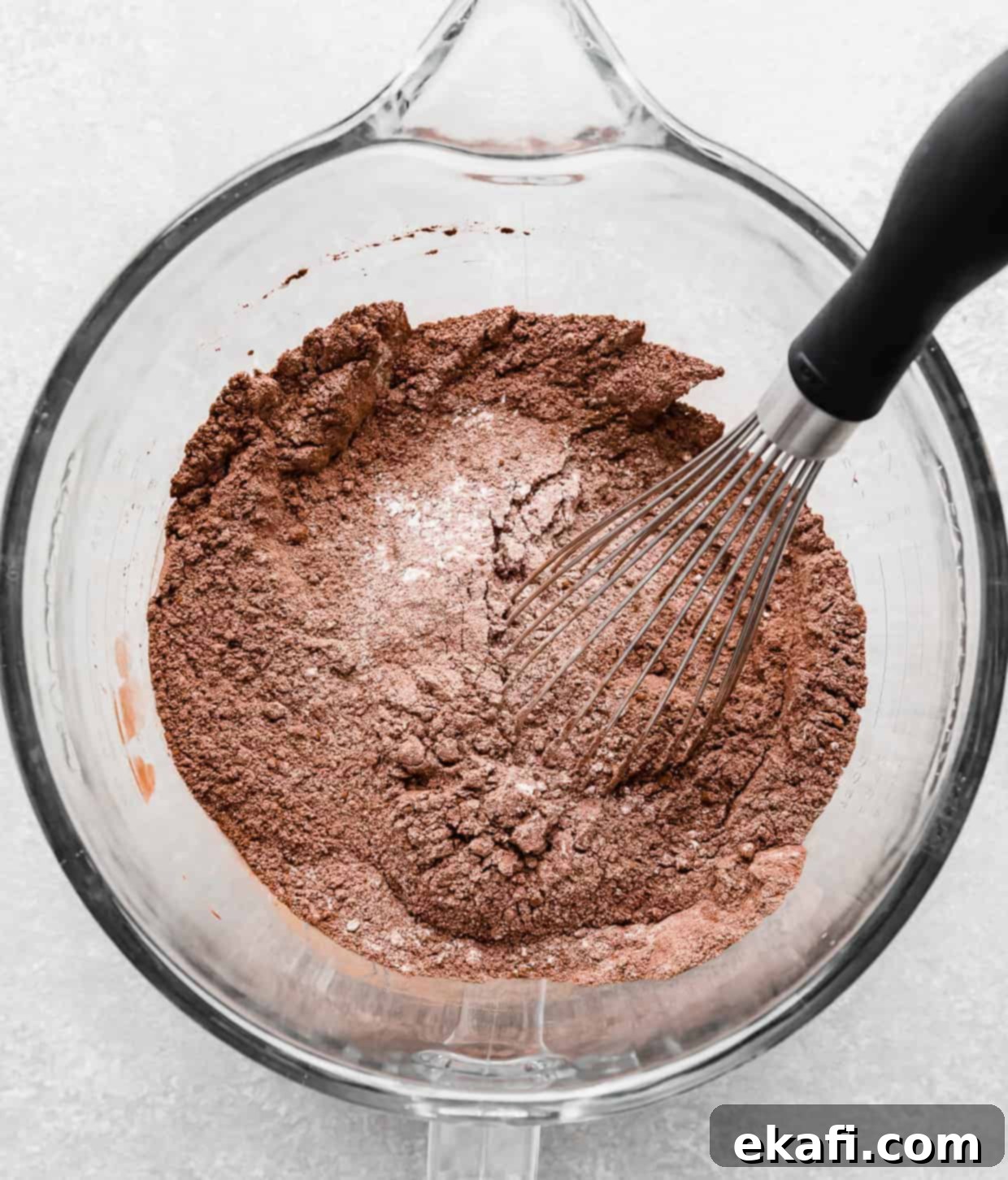
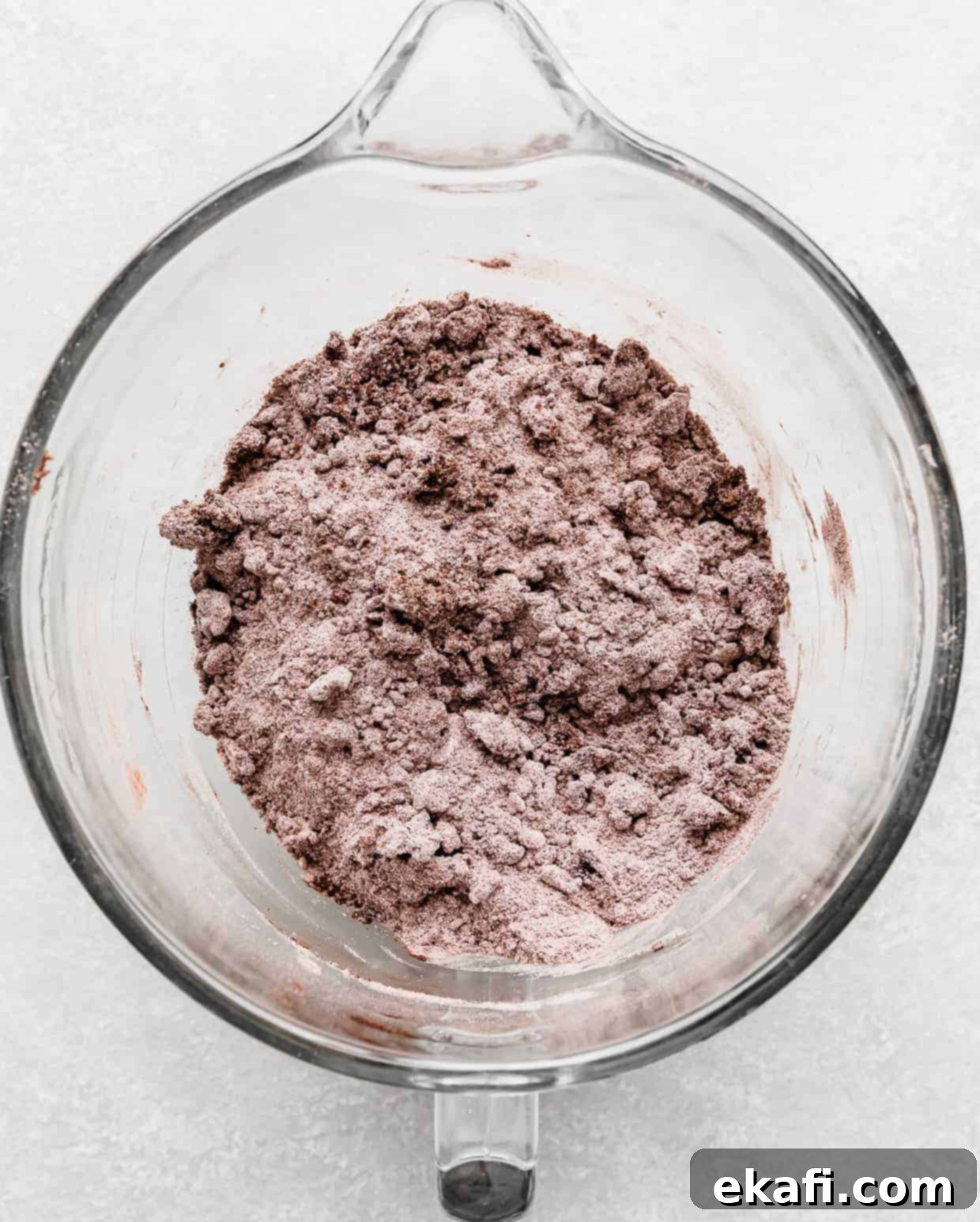
- Combine Wet Ingredients and Bloom Cocoa: In a separate large liquid measuring cup, whisk together the vanilla extract, milk, and hot water. The hot water will “bloom” the cocoa powder once added, intensifying its chocolate flavor. Pour this liquid mixture into the dry ingredients and butter mixture in the stand mixer. Mix on low speed until just combined. Be careful not to overmix; mixing too much can develop the gluten in the flour, leading to a tough cake.
- Add Eggs for Structure and Richness: Incorporate the large eggs one at a time, mixing briefly after each addition until just combined. Ensure each egg is fully integrated before adding the next. This gradual addition helps to create a smooth, emulsified batter. Once the batter is uniform, pour it into your prepared 9×13-inch baking pan, spreading it evenly.
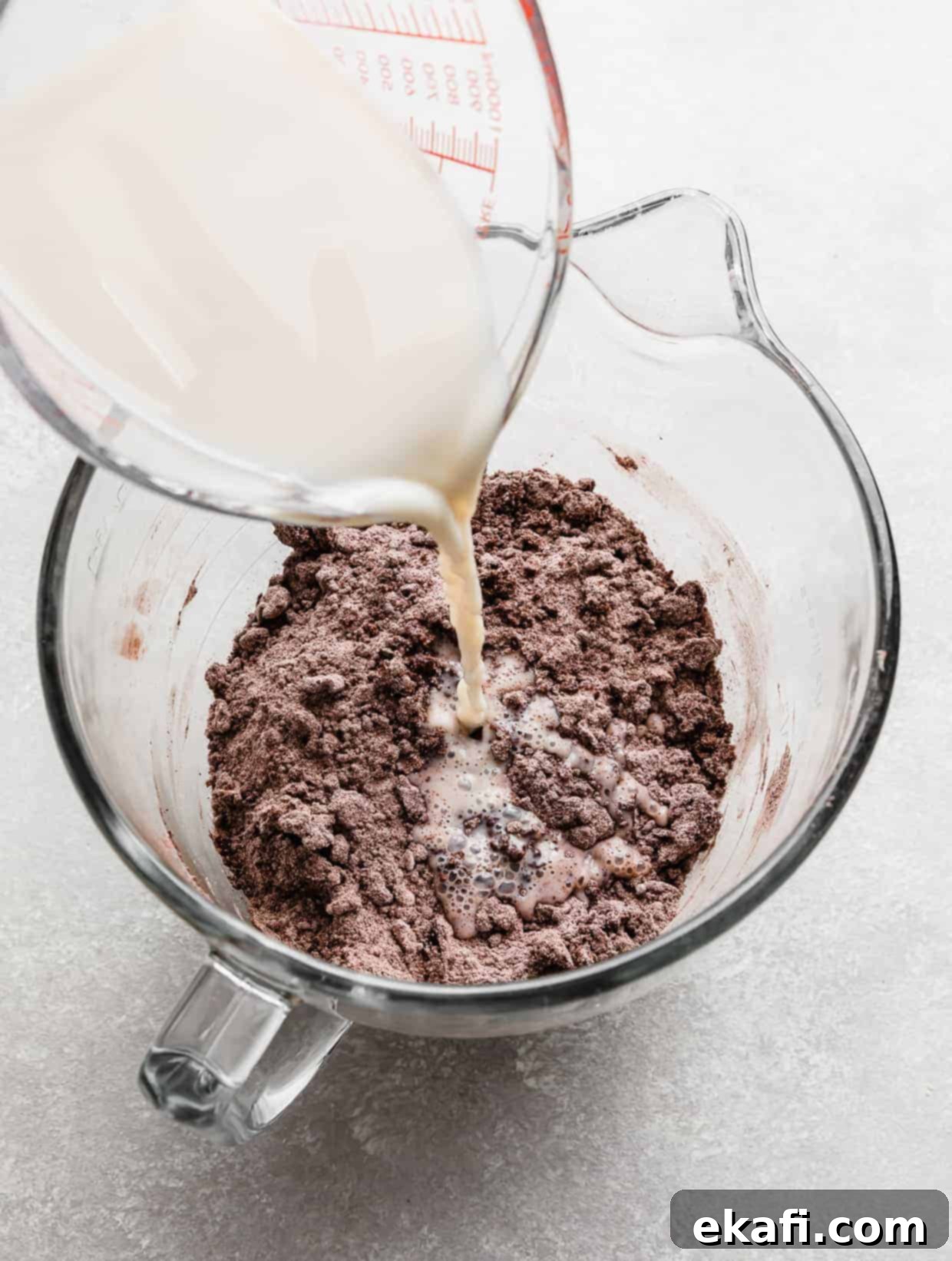
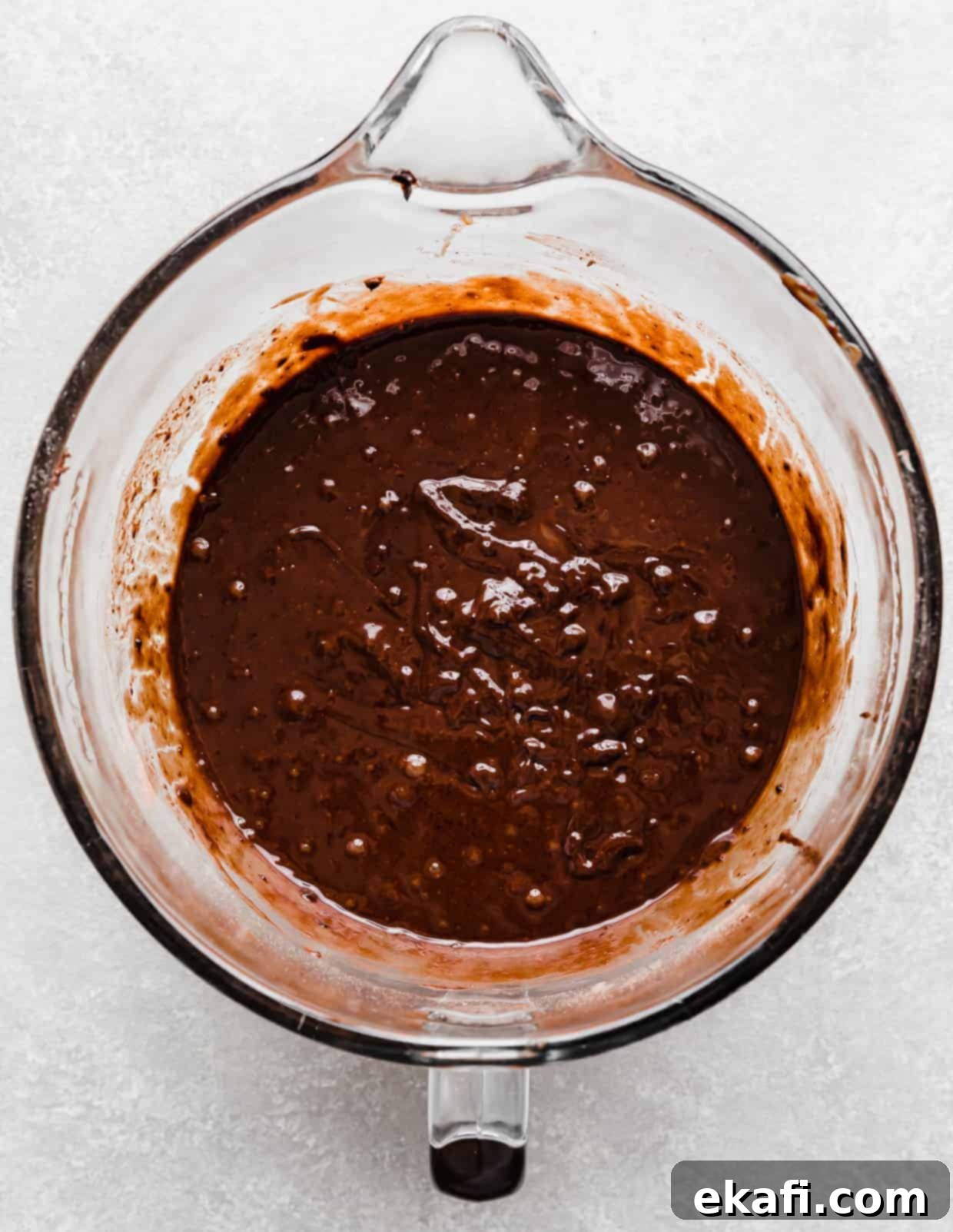
- Bake to Perfection: Place the pan in the preheated oven and bake for 28-34 minutes. The exact baking time may vary depending on your oven, so keep an eye on it. The cake is done when a wooden toothpick inserted into the center comes out clean or with a few moist crumbs attached. Avoid overbaking, as this is the primary cause of dry cake. Once baked, remove the cake from the oven and transfer it to a wire rack to cool completely. It’s crucial for the cake to be entirely cool before frosting to prevent the peanut butter buttercream from melting.
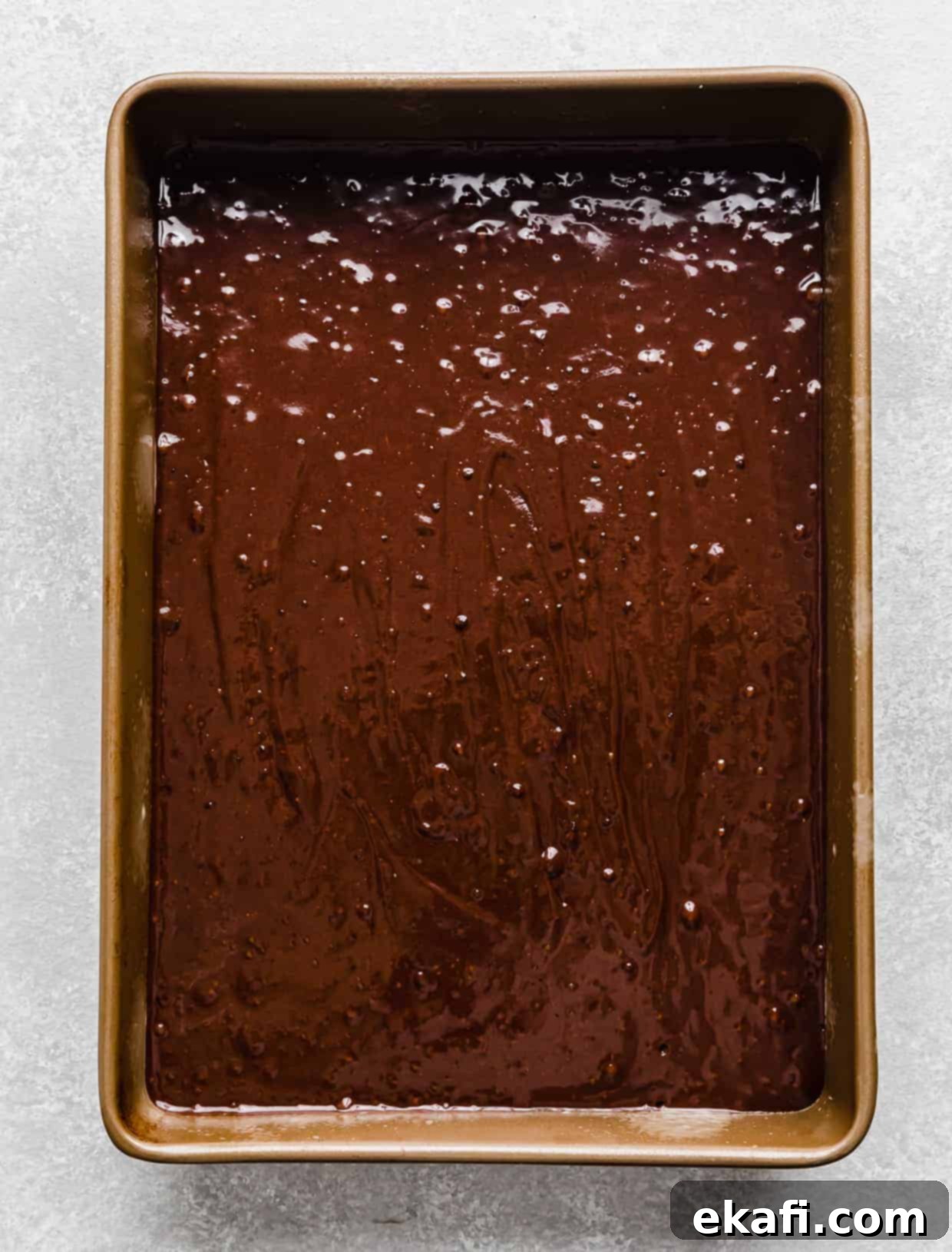
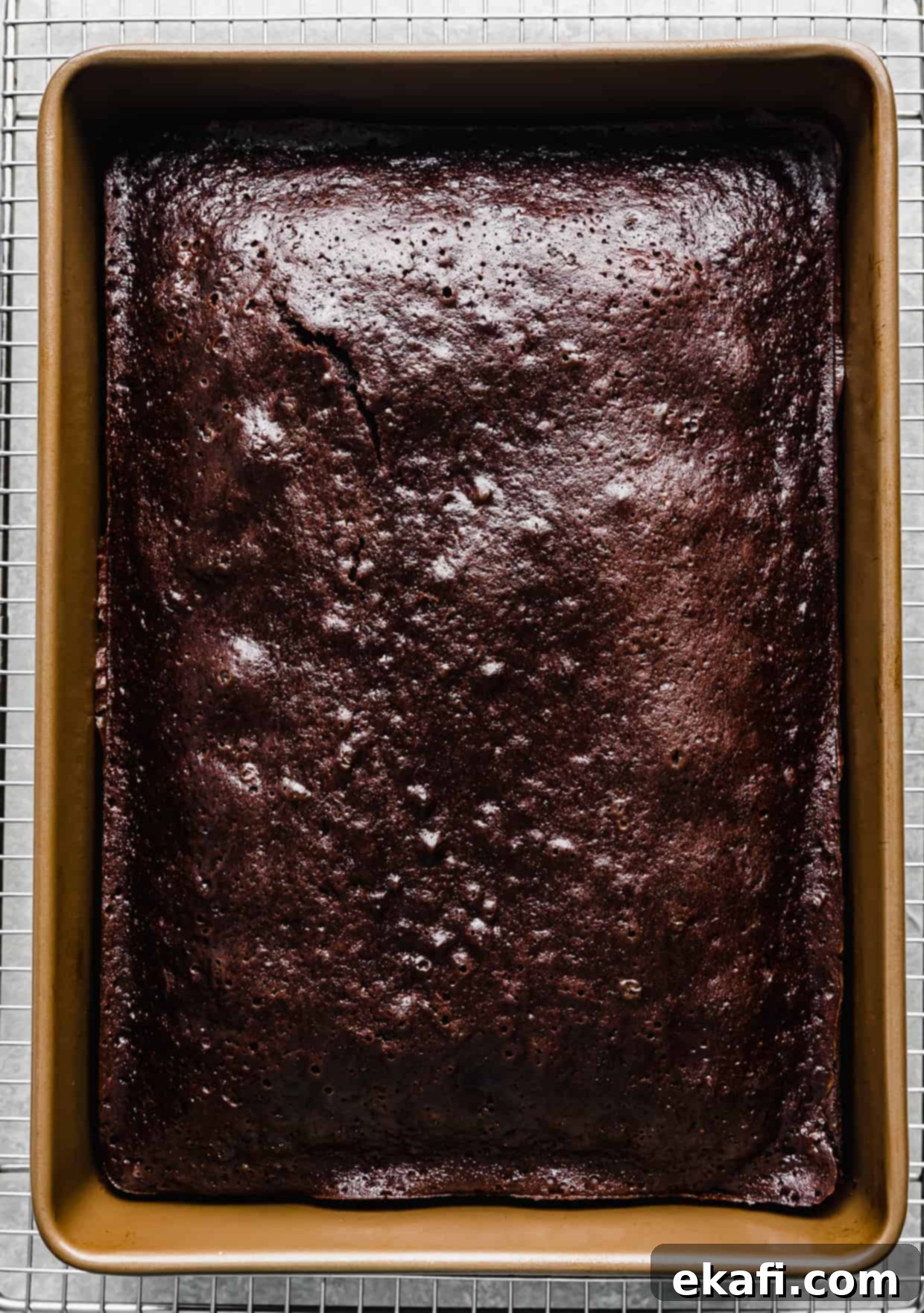
- Whip Up the Creamy Peanut Butter Frosting: While the cake cools, prepare my signature Peanut Butter Frosting recipe. This light, fluffy, and incredibly flavorful frosting is the perfect companion to the rich chocolate cake. Ensure your butter and peanut butter are at room temperature for the best consistency. Once the cake is completely cool, spread an even layer of the luscious peanut butter frosting over the top.
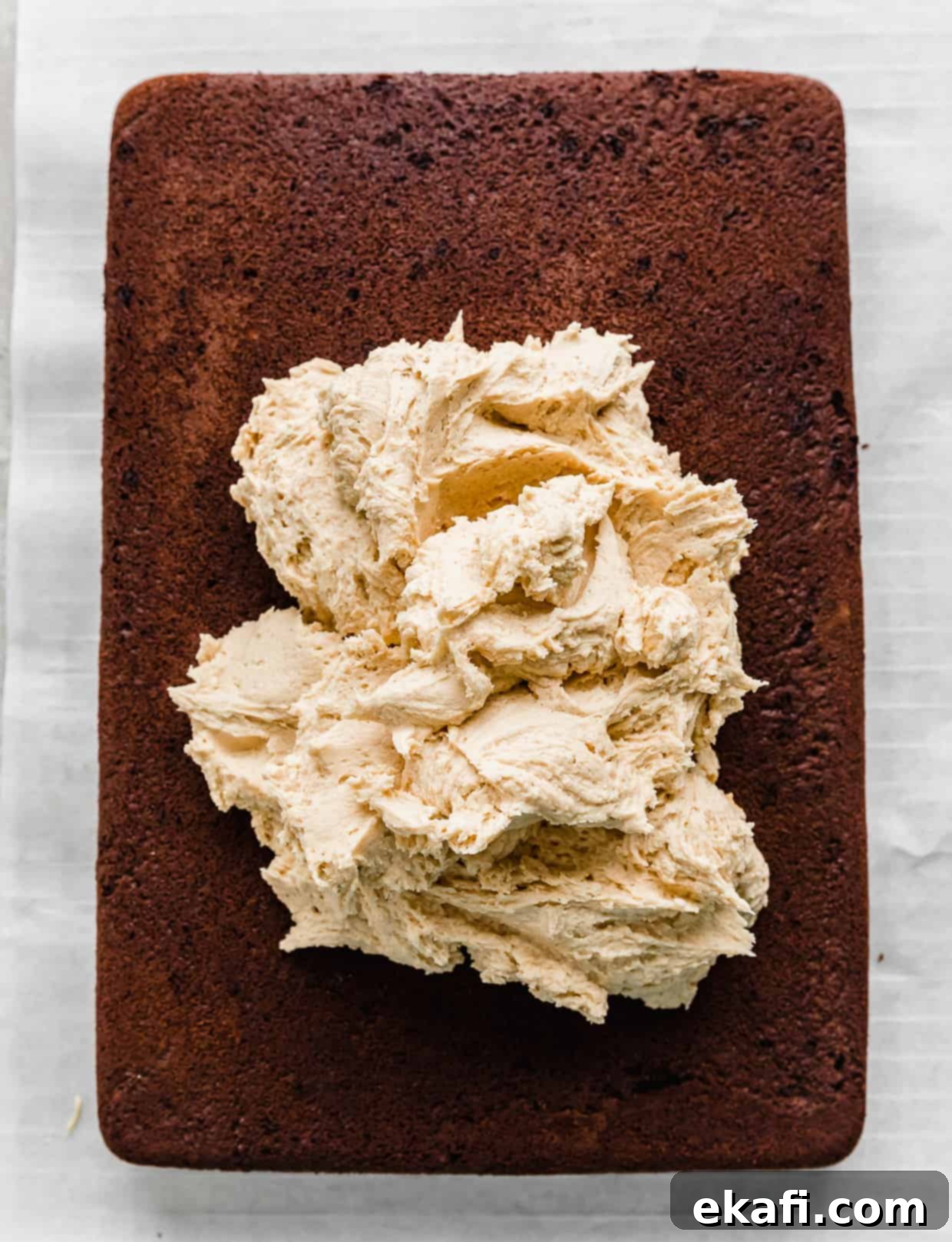
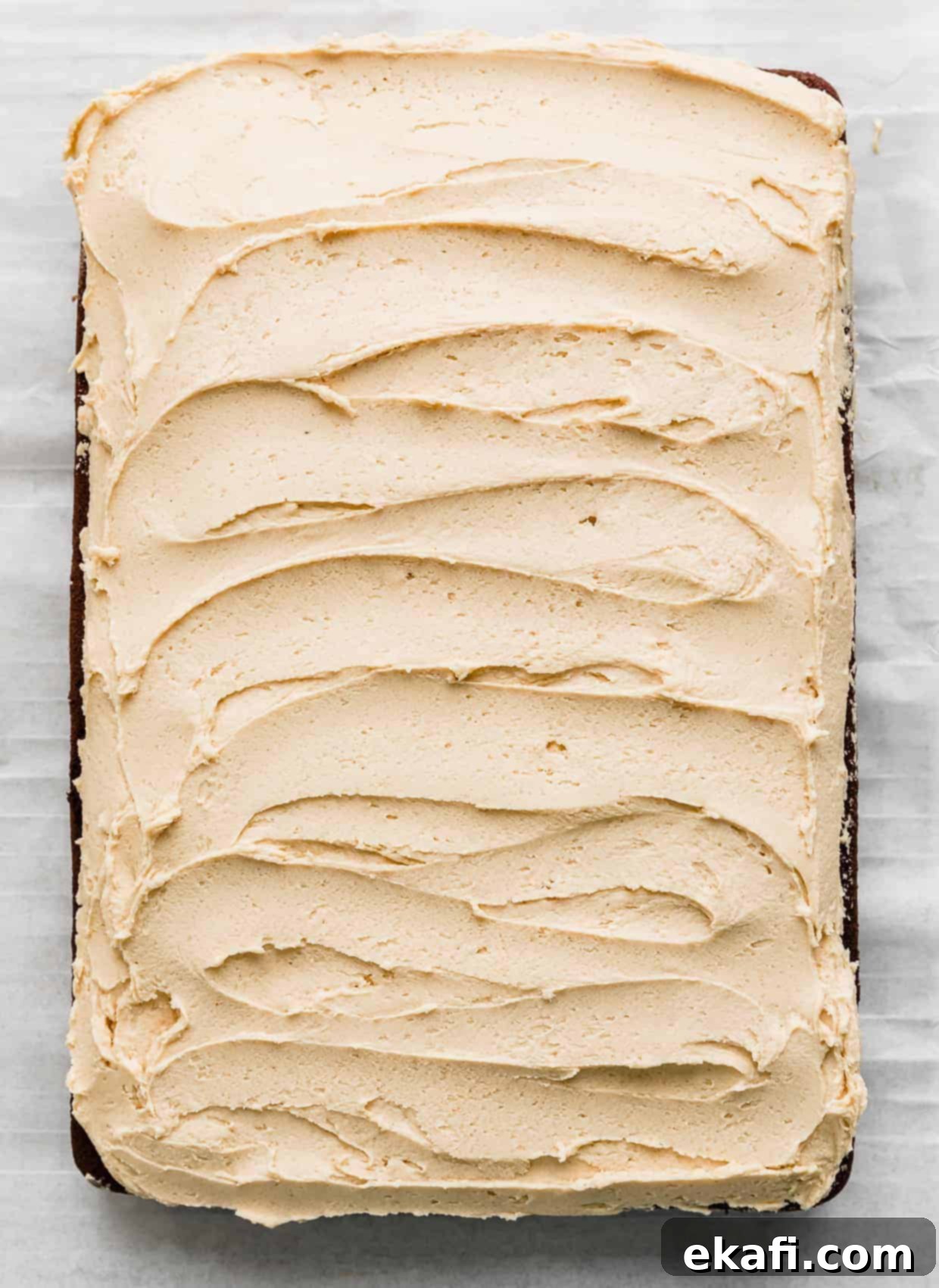
- Final Touches and Serving: For an extra touch of elegance and flavor, drizzle the frosted cake with melted chocolate or sprinkle with mini chocolate chips, if desired. This adds a beautiful visual element and another layer of chocolatey goodness. Once decorated, carefully cut the chocolate cake with peanut butter frosting into squares and serve immediately. Enjoy every glorious bite of this homemade masterpiece!
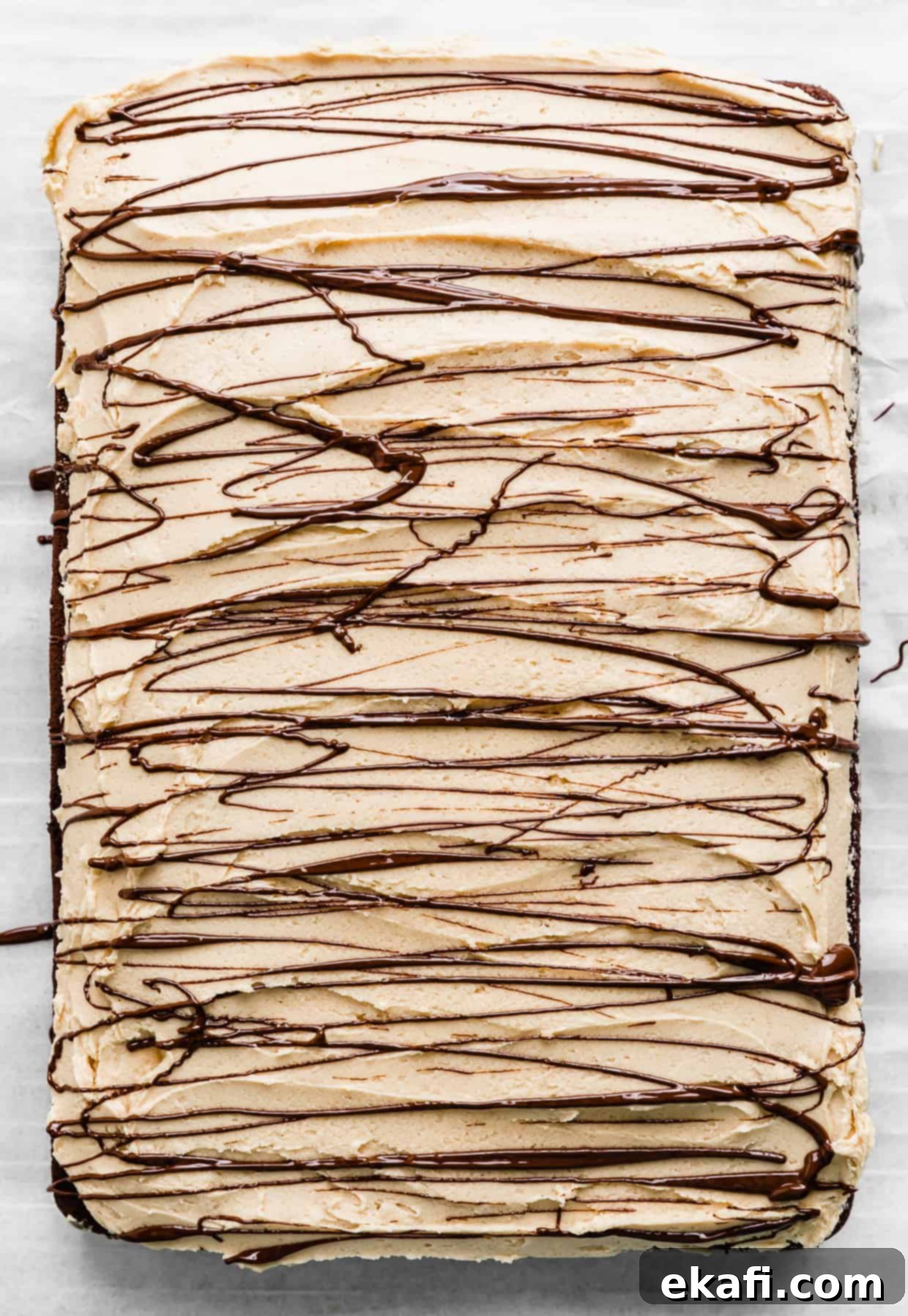
Expert Tips for Your Perfect Chocolate Peanut Butter Cake
Even the simplest recipes benefit from a few expert tips. These insights will help you achieve the best possible results for your chocolate cake with peanut butter frosting:
- Ensure Butter is Properly Softened: The butter used in both the chocolate cake and the peanut butter frosting needs to be very soft, but not melted. If you gently poke your finger into the butter and it leaves a clear dent without your finger going straight through, it’s at the ideal room temperature. This consistency is crucial for creaming it properly with sugar to incorporate air, which contributes to a light and tender cake texture and a fluffy frosting.
- Choosing the Right Cocoa Powder: As mentioned in the ingredient notes, I recommend Dutch-processed cocoa powder for this recipe. It provides a deeper, less acidic chocolate flavor and a richer, darker color that truly complements the peanut butter frosting. While you can use natural unsweetened cocoa, be aware that the cake’s color will be lighter, and the chocolate flavor won’t be as intense or mellow. The acid in natural cocoa also reacts more strongly with baking soda, which might slightly alter the cake’s rise if not balanced.
- Avoid Overbaking at All Costs: Overbaking is the quickest way to turn a potentially moist cake into a dry, crumbly disappointment. Begin checking your cake at the lower end of the suggested baking time (around 28 minutes). Insert a wooden toothpick into the center; if it comes out clean or with a few moist crumbs attached, your cake is done. Remove it from the oven promptly to preserve its moist texture.
- Do Not Overmix the Batter: Once you add the wet ingredients to the dry, mix only until they are just combined and no streaks of dry flour remain. Overmixing develops the gluten in the flour, which can lead to a tough, chewy, rather than tender, cake. Mix on low speed and stop as soon as the ingredients are incorporated.
- Room Temperature Ingredients for Best Emulsification: Beyond just the butter and eggs, having all cold ingredients (like milk) at room temperature allows them to blend more smoothly and evenly into the batter. This creates a more stable emulsion, leading to a finer crumb and better overall texture in your finished cake.
- Proper Pan Preparation: To ensure your cake releases easily and beautifully, thoroughly spray your 9×13-inch pan with a nonstick cooking spray that contains flour. If you don’t have this, grease the pan with butter or shortening, then dust it evenly with flour, tapping out any excess. This creates a barrier that prevents sticking.
Make Ahead, Storing, and Freezing Your Chocolate Peanut Butter Cake
This delicious chocolate cake with peanut butter frosting is not only a joy to make and eat but also quite forgiving when it comes to preparation and storage. Here’s how to manage it:
- Storing at Room Temperature: Once frosted, your chocolate cake with peanut butter frosting can be stored covered at room temperature for 2-3 days. Covering it tightly (a cake dome or airtight container works perfectly) will prevent it from drying out. While refrigeration can extend shelf life, it tends to make butter-based frostings and cakes a bit firm; room temperature usually keeps the cake at its most tender and the frosting at its creamiest.
- Making Ahead and Freezing Unfrosted Cake: You can certainly bake this cake ahead of time and freeze it for later enjoyment. Wrap the completely cooled, unfrosted cake tightly in two layers of plastic wrap. For freezing up to 1 week, this is sufficient. If you plan to freeze it for a longer period, up to 2 months, add an additional layer of aluminum foil over the plastic wrap for extra protection against freezer burn. When you’re ready to enjoy it, transfer the frozen cake to the refrigerator to thaw overnight. In the morning, move it to the counter to finish thawing to room temperature before applying the peanut butter frosting. This method ensures the cake retains its fresh taste and texture.
- Making Ahead and Storing Unfrosted Cake (Refrigerated): If you only need a day or two head start, you can store the unfrosted cake wrapped tightly in plastic wrap in the refrigerator for 2-3 days. Allow it to come to room temperature before frosting for the best results.
- Freezing Frosted Cake (Optional): While generally best enjoyed fresh or frozen unfrosted, you *can* freeze the frosted cake. Place the cake (uncovered) in the freezer for about an hour until the frosting is firm. Then, wrap it tightly in plastic wrap, followed by aluminum foil. Thaw in the refrigerator overnight. Be aware that the texture of the frosting might be slightly altered upon thawing.
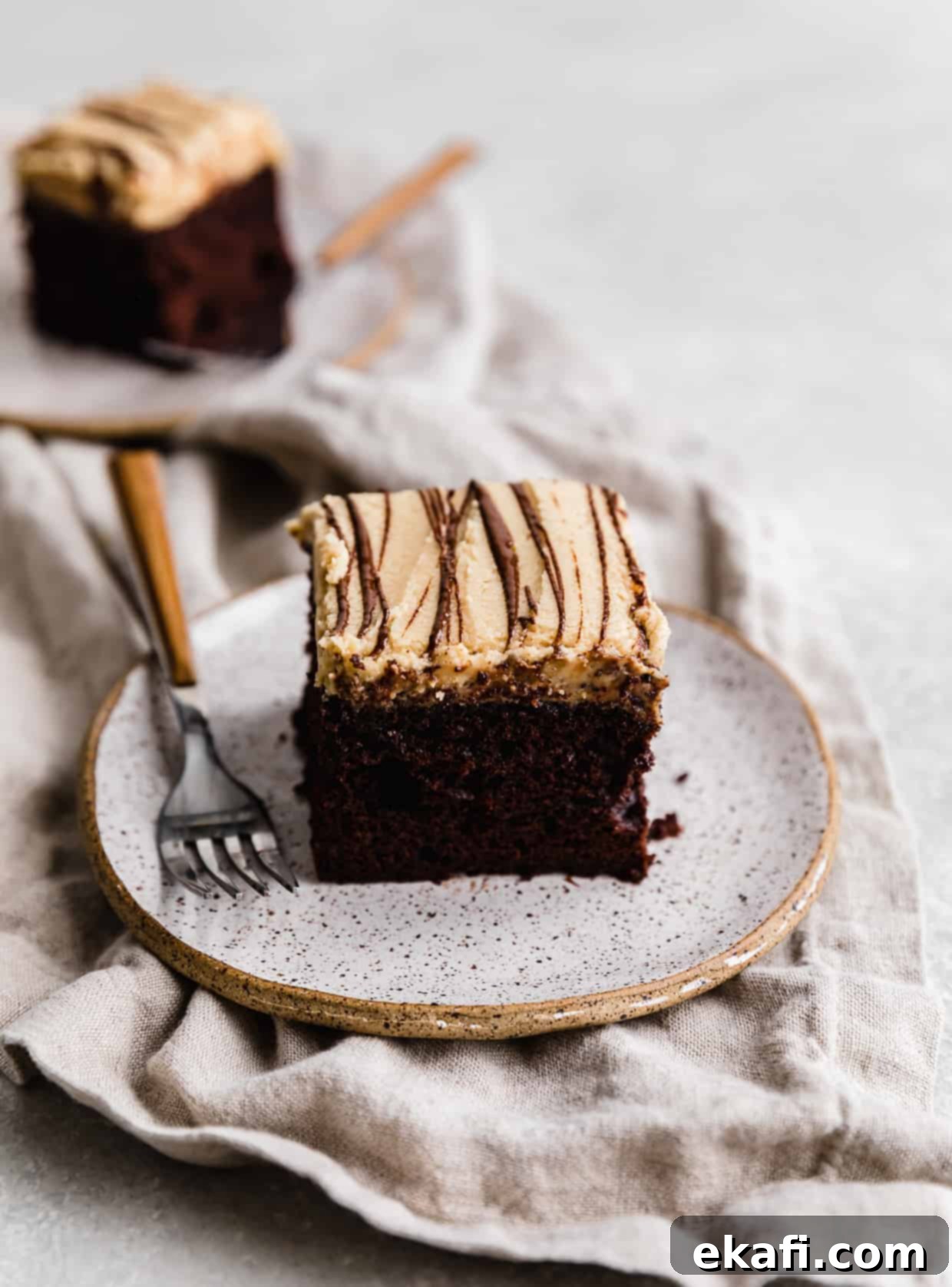
Chocolate Cake with Peanut Butter Frosting: Your Questions Answered
Baking can sometimes bring up questions, and I’m here to help! Here are some frequently asked questions about making the perfect moist chocolate cake with creamy peanut butter frosting:
Keeping a chocolate cake moist relies on a few critical factors. Firstly, incorporating vegetable oil into the batter is highly effective because oil remains liquid at room temperature, continuously distributing moisture throughout the cake’s crumb. Secondly, avoid overmixing your cake batter, especially after combining wet and dry ingredients. Overmixing develops gluten, leading to a tough, dry cake. Finally, don’t overbake! Use the toothpick test and remove the cake from the oven as soon as it’s done. Proper storage in an airtight container at room temperature also helps seal in that precious moisture.
Several elements contribute to a light and fluffy cake texture. Room temperature eggs help create a stable emulsion with fats, trapping air effectively. Proper creaming of butter and sugar is another key step, as it incorporates air, which expands during baking. Leavening agents like baking powder and baking soda are essential for creating gas bubbles that lift the batter. If using buttermilk (though this recipe uses regular milk), its acidity reacts with baking soda to create an extra boost of rise. Lastly, sifting dry ingredients and gently folding them into the wet ensures a tender crumb by preventing over-mixing and over-developing gluten.
Milk serves multiple important functions in a cake. It adds significant moisture, which contributes to a tender and palatable crumb. Beyond hydration, milk enhances the overall flavor profile and can influence the browning of the cake’s crust due to its sugar content. It also plays a role in the structure, helping to create a delicate and well-developed texture.
While you can technically substitute natural cocoa powder, it’s not recommended for this specific recipe if you want the exact intended flavor and color. Dutch-processed cocoa is less acidic, resulting in a darker, mellower chocolate flavor that perfectly complements the peanut butter frosting. Natural cocoa is acidic and provides a lighter color and a slightly sharper chocolate note. If you must use natural cocoa, the cake’s color and richness will be different, and sometimes the leavening agents (baking soda/powder) might need slight adjustments depending on the recipe’s balance, as natural cocoa reacts more strongly with baking soda.
For the creamiest, most stable peanut butter frosting, it’s best to use a classic smooth, creamy peanut butter (like Jif or Skippy). Avoid natural peanut butter that separates, as the oil content can make the frosting greasy, unstable, and difficult to achieve the desired fluffy consistency. The sugar and stabilizers in conventional creamy peanut butter are key to a perfect buttercream.
Absolutely! This versatile chocolate cake batter works wonderfully for cupcakes. Simply line a muffin tin with paper liners and fill each about two-thirds full with batter. Bake at 350°F (175°C) for approximately 18-22 minutes, or until a toothpick inserted into the center of a cupcake comes out clean. Adjust baking time as needed. Once cooled, you can pipe the peanut butter frosting on top for delightful individual treats!
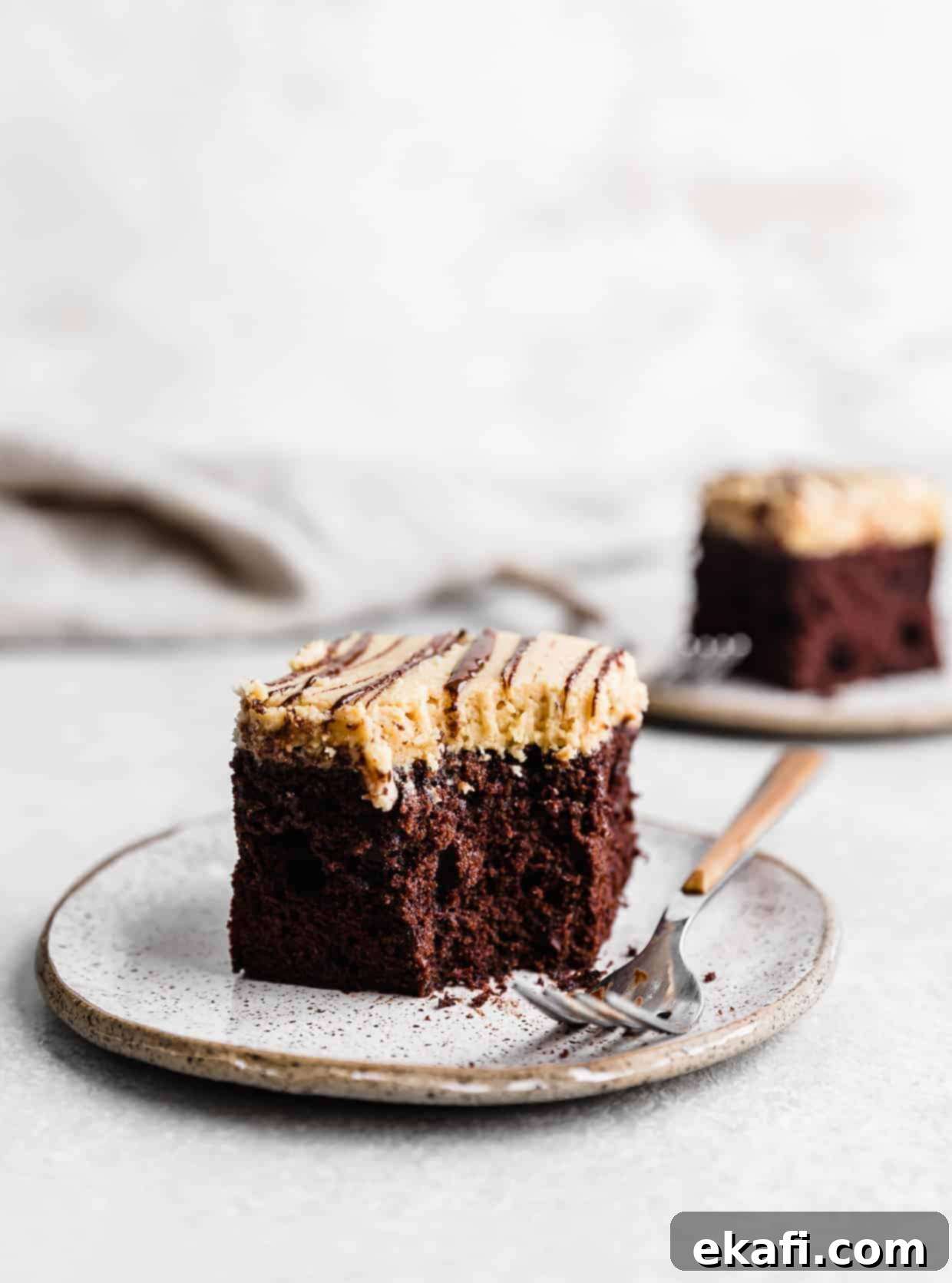
Discover More Decadent Chocolate Recipes
If you’re a true chocolate lover, your culinary adventure doesn’t have to end here! Explore these other fantastic chocolate-filled recipes:
- Chocolate Doughnuts: Start your day with a sweet treat or enjoy a delightful dessert with these homemade chocolate doughnuts, perfect for any occasion.
- Double Chocolate Chip Cookies: For the ultimate chocolate fix, these cookies are packed with rich cocoa and generous chocolate chips, delivering pure bliss in every bite.
- Homemade Chocolate Pudding: A classic comfort dessert, this creamy and rich chocolate pudding is incredibly easy to make from scratch and far superior to any store-bought version.
- Chocolate Cupcakes: Perfect for parties or individual servings, these moist and tender chocolate cupcakes are a staple that everyone will adore.
- Chocolate Buttermilk Bundt Cake: An elegant and equally moist chocolate cake, this bundt version uses buttermilk for an extra tender crumb and a subtle tangy depth.
Did you make this incredible Chocolate Cake with Peanut Butter Frosting recipe? I’d absolutely love to hear about your experience! Leave a rating and review below, or simply scroll down to the recipe card and share your thoughts there. Your feedback helps me and other bakers!
Stay sweet and up-to-date with all my latest recipes and baking adventures by following us on Instagram, TikTok, Facebook, and Pinterest. Don’t forget to tag me if you share your creations!
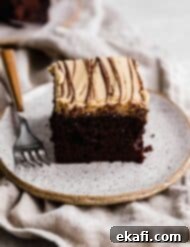
Print
SaveSaved!
Review
Chocolate Cake with Peanut Butter Frosting
Ingredients
Chocolate Cake
- 2 1/4 cups all purpose flour
- 1 1/2 teaspoon baking powder
- 1/2 teaspoon baking soda
- 1/2 teaspoon salt
- 3/4 cup Dutch process cocoa powder – see notes for cocoa powder details
- 1 1/2 cups granulated sugar
- 1/2 cup unsalted butter – very soft, at room temperature
- 1/3 cup vegetable oil – neutral flavored
- 2 teaspoons vanilla extract
- 1 cup milk – I used 2% but any percentage will be fine, at room temperature
- 1/2 cup hot water – for blooming cocoa
- 4 large eggs – at room temperature
Peanut Butter Frosting
- 1 cup unsalted butter – softened to room temperature
- 1 cup creamy peanut butter – not natural/oily, at room temperature
- 3 1/2 – 4 cups powdered sugar – confectioners’ sugar
- 1 teaspoon vanilla extract
- 1/4 teaspoon salt
- 1 tablespoon milk – if needed for consistency
Equipment
-
Kitchen Aid stand mixer
-
nonstick 9×13 pan
-
liquid measuring cups
-
Wire rack
Instructions
Chocolate Cake
-
Preheat oven to 350°F (175°C). Prepare a 9×13 inch pan by spraying it thoroughly with nonstick cooking spray that contains flour, or by greasing and flouring it. Set aside.
-
In the bowl of a stand mixer fitted with a paddle attachment, thoroughly whisk the flour, baking powder, baking soda, salt, Dutch process cocoa powder, and granulated sugar. Add the very soft butter and vegetable oil to the dry ingredients and mix on low speed until the mixture resembles coarse sand.
-
In a large liquid measuring cup, whisk together the vanilla, room temperature milk, and hot water. Pour this liquid mixture into the dry ingredients and butter mixture in the stand mixer. Mix on low speed until just combined, being careful not to overmix.
-
Add the large eggs one at a time, mixing after each addition until just incorporated. Once the batter is fully combined and smooth, pour it into the prepared baking pan, spreading evenly.
-
Bake for 28-34 minutes, or until a wooden toothpick inserted into the center of the cake comes out clean or with a few moist crumbs attached. Remove the cake from the oven and place it on a wire rack to cool completely before frosting.
Peanut Butter Frosting
-
Make the frosting: In the bowl of a stand mixer (or using a hand-held electric mixer), beat the softened butter and creamy peanut butter together until light, creamy, and well combined. With the mixer on low speed, gradually add the powdered sugar, ½ cup at a time, until all of the powdered sugar has been incorporated. Scrape down the sides of the bowl as needed to ensure everything is mixed.
-
Mix in the vanilla extract and salt. Increase the mixer speed to medium-high and beat for an additional 30 seconds to 1 minute, until the frosting is light and fluffy. If the frosting is too thick, add milk 1 tablespoon at a time until desired consistency is reached.
-
Once the chocolate cake is completely cool, spread the luscious peanut butter frosting evenly over the top.
-
Optionally, top the cake with mini chocolate chips or drizzle melted chocolate over the frosting for an extra decorative and delicious touch. Slice and serve!
Notes
Milk: I used 2% milk, but whole milk or even buttermilk can be used as well. Ensure it is at room temperature.
Cocoa Powder: For the best results in terms of color and deep, mellow chocolate flavor, I recommend Dutch-processed cocoa powder. If using natural unsweetened cocoa powder, the cake will be much lighter in color and won’t have as rich of a chocolate flavor, and the acidity balance might be slightly different. Read my Best Cocoa Powder for Baking post for more information on the differences of cocoa powders.
Store the frosted cake covered at room temperature for 2-3 days for optimal freshness and texture.
To freeze the unfrosted cake, wrap it tightly in two layers of plastic wrap, then an additional layer of aluminum foil for longer storage (up to 2 months). Thaw in the refrigerator overnight before bringing to room temperature and frosting.
This rich chocolate cake recipe was adapted from a reliable source like King Arthur Flour, with my personal touches for perfect moisture and flavor.
Nutrition
